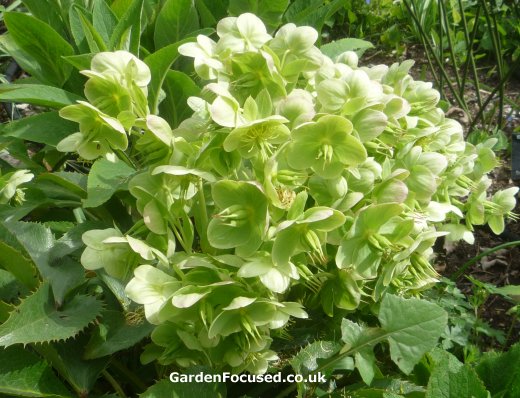GROWING HELLEBORES
Article by David Marks
Hellebores flower in winter to early spring and are small plants, easily missed at that time of year. So if you plan to grow some, and they are well worth it, be sure to plant them somewhere where they will be appreciated.
Ours are planted in a semi-shady spot near the back door so whenever I venture out into the garden in the chill of winter and early spring they can easily be appreciated. Another excellent place to grow them is by the borders of a path.
Corsican Hellebore
Use the checklist below to decide if Hellebores are suited to your needs and garden conditions
- They do best in semi-shade.
- They are fully hardy in all areas of the UK.
- They grow well in most soils although avoid waterlogged or dry soils. Their preference is for a slightly alkaline soil but in truth they will grow alongside acid loving plants as well.
- They will not withstand drought well. If their position is liable to dry out, water occasionally.
- Hellebores are low maintenance plants. They benefit from a quick clear up in late autumn and on poor soils they will grow better with a twice yearly organic feed.
- They are grown mainly for their flowers which appear from early January to mid-March.
- There are pests and disease which affect hellebores but they are, on the whole, healthy plants.
- Some are evergreen and some shed their leaves, it depends on the variety. They grow to a height and spread of 30cm / 1ft to 1m / 3ft depending on the variety.
- Single flowered hellebores attract bees at a time of the year when little else does.
- Hellebores are also frequently called Christmas Rose or Lenten Rose.
BEST CONDITIONS TO GROW HELLEBORES
Hellebores grow and flower best if they are are given as near as possible the same conditions as when they grow in the wild. The Germans call hellebores Schneerose which means “snow rose”, often more appropriate than the common English name of Christmas Rose. In fact, many hellebores don’t flower at Christmas, they prefer to wait until January in the UK, although some new varieties have been bred to be dependable Christmas bloomers.
They are most commonly found at the lower heights of mountains where the snow melts and easily drains away. Where they grow amongst trees, the trees are deciduous and shed their leaves in winter allowing the plants underneath to have lots of sunlight during winter and early spring.
From the above we recommend good draining ground, moisture at the roots, a sunny position during the winter months and dappled shade during the remainder of the year.
If you have a deep loam soil then that’s ideal. The next best soil is clay which has been improved with lots of well-rotted organic matter. Sandy soils are the least favourable although the addition of well-rotted organic matter can greatly improve your chances of growing quality hellebores.
DIFFERENT VARIETIES OF HELLEBORES
There are many varieties of hellebores and the number is increasing at a rapid rate as plant breeders produce new ones. In order to ensure that a hellebore grows true to type the plant growers need to isolate each variety and this makes them expensive to grow and of course, expensive to buy.
Combine that with their long life and it’s important to choose the best variety for your garden and preferences. Our guide to hellebore varieties aims to do just that, click here to go to that page.
WHERE AND WHEN TO BUY HELLEBORES
Breeding hellebores is very time-consuming and to end up with a decent variety takes significant skill. There are many low quality plants sold in the UK and they rarely turn out to be anything other than a disappointment. For that reason, stick to online names you know such as Crocus. Remember also, when comparing prices to take into account how large the plant is.
Seed grown hellebores can vary in colour. As a general rule, the cheaper the plant the more likely it is to be different from the parent. See our varieties page for hellebore series which are better than most. To get exactly the colour you want from a seed-grown hellebore you need to see it in flower. For this reason many nurseries only sell their plants when they are in flower – typically January to March.
If you select from one of the more reliable series where the colour will be very, very similar to the parent, it’s quite possible to buy hellebores in pots all the year through. Just ensure that for the first season they are watered in dry conditions.
One way to be 100% certain of getting an exact replica of the parent is to buy micro-propagated plants. These also are available all year round.
Our
recommendation would be Anna’s Red here, a stunning red-purple bloom, held high above the mottled, green leaves.
HOW AND WHEN TO PLANT A HELLEBORE
Hellebores can be planted at any time of the year. For some it’s most convenient to plant in late winter to early spring because that is when the majority are offered for sale. Follow the steps below:
- Choose a position that is in part shade.
- Choose a position which does not get water-logged. Improve drainage if necessary by adding a couple of spade fulls of well-rotted compost and horticultural grit to the soil when you plant the hellebore.
- They have no preference for slightly acid or alkaline soils and will thrive in clay soils that are improved.
- Dig a hole about 30cm / 12in deep and wide. Break up the soil incorporating any available compost. Add three handfuls of fish, blood and bone fertiliser (or bonemeal) to the dug soil and work it in.
- Replace sufficient soil back in the hole so that when your hellebore is planted it will be to the same level as it was in the pot.
- Place the roots in the hole and infill with the dug soil / compost / fertiliser. Firm the soil down around the roots reasonably firmly as you infill.
- Water well if the ground is at all dry.
CARING FOR HELLEBORES
Hellebores will grow without any care at all as long as you keep the surrounding area weed-free. They are hungry plants though and will do better if fed with a good handful of fish, blood and bone fertiliser in March and then again September. Simply sprinkle the fertiliser around the plant and gently work it into the soil surface.
Hellebores can suffer from fungal diseases and the single best action you can take to avoid this is removing any dead or dying leaves in late November to December. This lets air circulate around the base of the plant and generally keeps them healthy, it’s also easier to see the flowers without a mass of dead leaves. As the the flowers die down in March / April cut the dead stems away for the same reason. Do not put any foliage or flowers on the compost heap.
PESTS AN DISEASES OF HELLEBORES
We list below some of the common pests and diseases which may affect your hellebore plants.
APHIDS
It’s a good idea to check your hellebores once a moth for aphids. Look on the underside of young leaves for white flecks (the shed skin of aphids) and the aphids themselves. Theses pests suck the sap and give out a sticky sweet liquid which attracts ants, fungi and diseases in general. See Hellebore Black Death below, aphids are thought to transmit this disease from plant to plant. Click here for our page on treating aphids.
BLACK SPOT
This is most likely to affect plants of three or more years old. Black spots appear on leaves and as flower buds push through these are also marked black as will the blooms be when they emerge. Flower stems may wil and die. It is caused by the fungus Microsphaeropsis hellebori.
There are no fungicides specifically designed to treat Hellebore Black Spot but most plant fungicides will help control the problem. The best solution is to clear away all older leaves in November to December to stop the problem spreading and infecting new growth.
HELLEBORE BLACK DEATH
This is most likely to affect plants of three or more years old. The symptoms are blackened leaf veins, random black streaks on almost all parts of the plant. The disease is slow to progress and normally only kills the plant a year after the first symptoms.
Infected plants should be dug up and burnt. There is no treatment, chemical or otherwise. Aphids are thought to be the mechanism that transmits the infection. Although this disease has a dramatic name it rarely affects hellebores in the average garden, it is more likely to be a problem in massed plantings and at plant nurseries.
SLUGS AND SNAILS
Fully grown hellebores can have their flowers eaten by slugs and snails but it’s not common. Much more likely is that tender young seedlings are eaten. The best cure is to keep the seedlings in pots away from slugs and snails. Plant out when they are a year or so old and less likely to be damaged.
GROWING HELLEBORES IN CONTAINERS / POTS
You might not think it, given their relatively small size but hellebores do best when their roots are allowed to go down deep – width is not so important. if you plant a hellebore in a container start them off in a pot 40cm / 16in deep or more and then re-pot every two years into a pot 5cm / 2in
deeper. When the pot depth reaches 60cm / 2ft that should be sufficient.
Not to get to dreamy eyed, but a hellebore in a pot / container placed near where you pass it frequently is a real delight. The height of the pot makes the plants more visible and it can be positioned to give the very best conditions. Full sun in winter and spring, then partial shade for the rest of the year.
Use John Innes compost and horticultural girt in the pot with a layer of stones at the base to provide drainage. You will need to keep the pot watered but with a relatively large one that is not too difficult. A twice yearly feed with a large handful of fish, blood and bone twice a year in March and September will provide all the nutrients your hellebore needs and it’s organic.
HELLEBORE SUMMARY
Below we list the key strengths and weaknesses of Hellebores.
| HARDY | |
| CLAY SOIL | Yes but not water-logged |
| SANDY SOIL | Yes if improved |
| DRY SOIL | No |
| SHADE | No, partial shade is best although they will tolerate full sun |
| EVERGREEN | Yes |
| EASY CARE | |
| SMALL GARDENS | Yes |
| POT / CONTAINER | Yes |
| FLOWERING | |
| FLOWER TIME | Late January to mid March |
Other “easy-care” shrubs in this series include
Choisya, Hebes, Skimmia, Lilacs, Potentilla and
Rose of Sharon (hibiscus syriacus).

